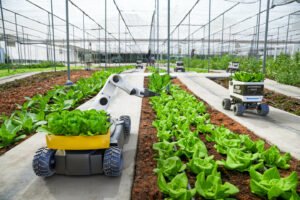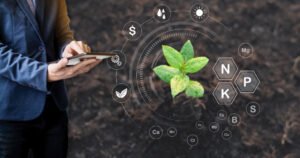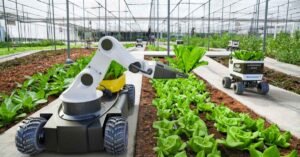In modern agriculture, new technologies are dramatically changing the way we care for plants. Artificial intelligence-powered identification of crop diseases is one of the new ideas gaining widespread attention. This revolutionary approach uses artificial intelligence and promises to quickly and correctly detect diseases in the field, giving farmers a powerful tool to protect their crops and ensure there is enough food for everyone. This article discusses how complex AI-powered crop disease detection is, what it is used for, how it can help, and how it can change the future of agriculture.
Discover Important Components of Crop Diseases using Artificial Intelligence:
1. Use Artificial Intelligence
Artificial intelligence, and especially machine learning algorithms, are at the heart of using artificial intelligence to detect crop diseases. The algorithms are trained on large amounts of images of healthy and diseased plants, allowing them to spot small changes and patterns associated with various diseases.
2. View the Image Analysis
Image analysis and detection are an important part of this technology, which often uses deep learning methods. Artificial intelligence systems can tell when crops are diseased by looking at them and noticing physical signs such as redness, sores or strange growth patterns. This level of accuracy allows diseases to be detected early, even before symptoms are fully visible.
3. Make Decisions based on Data
Data is important for AI-driven identification of crop diseases. As the system looks at more images and learns from different data sets, it gets better at making choices based on the data. Farmers have immediate access to information, preventing the spread of disease and minimising food loss.
Why is AI-Driven Crop Disease Detection a Good Idea?
1. Early Signs and Quick Action
One of the biggest advantages is the early detection of crop diseases. Artificial intelligence algorithms can spot small signals that the human eye might miss. This allows agricultural companies to act quickly with measures such as targeted treatment or isolation of diseased areas.
2. Precision Agriculture Practise
Precision agriculture is in line with the idea of using AI to detect food diseases. By accurately identifying the location and extent of disease outbreaks, farmers can make optimal use of resources such as chemical fertilisers and pesticides, reducing environmental damage and overall input costs.
3. Improve Crop Quality and Yield
AI-driven detection makes it easier to act quickly, improving crop yield and quality. Farmers can protect the health of their crops by preventing the spread of disease and ensuring that their harvests meet quality standards and market demands.
Implementation of Artificial Intelligence Solutions in Agriculture:
1. Remote Sensing Technology
Artificial intelligence is often used in combination with remote sensing technologies such as drones and satellites to detect crop diseases. These technologies can take high-resolution photos of large areas of agricultural land, providing a comprehensive picture of crop health. Artificial intelligence systems then look at these images to find places where the disease can spread quickly.
2. Smartphone App for Testing on the Go
Some AI-based options are being developed as smartphone apps that allow farmers to take and upload photos directly in the field. The app then analyses the image on-the-fly and immediately tells you how likely crop diseases are to occur. This mobile approach makes it easier for farmers to access and use it.
3. Work with Agricultural Experts
Artificial intelligence-powered crop disease detection tools can help farmers do their jobs better. When AI technologies and human experts work together, they create a collaborative approach where the AI system performs rapid and scalable analysis and the human experts provide recommendations and insights based on the situation.
Questions and Things to Think About
1. Data Quality and Diversity
The quality and variety of data used to teach artificial intelligence to detect crop diseases determine its effectiveness. Ensuring that the AI system sees many pictures of different plants and diseases is important to ensure that it works correctly and consistently.
2. Infrastructure and Internet Access
Using AI options can be more difficult in places with poor infrastructure and connectivity. Some farmers don’t use these tools because they don’t have access to high-speed internet or the necessary hardware.
3. How Much Does Adoption Cost
Some farmers may not be able to afford AI-powered tools that can detect crop diseases in the first place. For investments in technology, training and ongoing maintenance to be widely used, especially by small-scale farmers, they may need financial support or incentives.
Future Trends and Inventions:
1. Interact with the Robot System
In the future, artificial intelligence-powered field disease detection systems may be combined with robotic systems. Equipped with cameras and sensors, the robot platform can move through the area and detect and treat diseased plants themselves. This seamless merger makes the disease management process more efficient.
2. Blockchain to Keep Track of Things
Blockchain technology can make it easier to track crops on farms. Blockchain can securely store data on crop diseases discovered by artificial intelligence, as well as data on treatments and outcomes. This public register helps build trust in the supply chain and ensures standards for agricultural products.
3. Global Collaboration to make Datasets more Diverse
To make artificial intelligence programmes more accurate and useful in more situations, collaboration across the world is necessary. By working together, agricultural groups around the world can produce large, diverse data sets that allow AI-powered systems to reliably and effectively detect crop diseases across all crops and regions.
Conclusion:
Artificial intelligence-powered identification of crop diseases is a great example of how technology can improve agriculture. By combining artificial intelligence with agriculture—something we have been doing for a long time—we are giving farmers the tools they need to make informed choices, protect their crops and build a sustainable and resilient future for agriculture. As technology advances and agriculture changes, a combination of human knowledge and artificial intelligence (AI) has the potential to improve crop health, increase yields and help ensure food security around the world. In the realms of tomorrow, wisdom and devotion will grow together to produce abundant wealth.
FAQs:
1. How does artificial intelligence-driven crop disease detection work, and how does it differ from traditional methods?
Artificial intelligence-powered crop disease detection uses machine learning algorithms trained on massive data sets to analyse crop images. It differs from traditional methods in that it allows early and accurate identification of diseases through image recognition, allowing proactive measures to be taken before obvious symptoms appear.
2. Can AI-driven crop disease detection be used for all types of crops? Does it work in different regions?
Yes, AI-driven crop disease detection can be applied to a variety of crops. Its effectiveness is enhanced by a variety of datasets, which ensure that the algorithm is trained on images representing different crops and diseases. This approach can be adapted to different regions and agricultural practises.
3. How can farmers access and implement AI-driven crop disease detection on their farms, especially in areas with limited internet connectivity?
Farmers can access AI-powered solutions in a variety of ways, including smartphone apps or collaborations with agricultural experts. In areas with limited connectivity, offline applications or localised solutions can be used to ensure accessibility and availability for farmers.
4. What challenges do farmers face in adopting AI-driven crop disease detection? How do you deal with these challenges?
Challenges include data quality, infrastructure limitations, and initial adoption costs. Addressing these challenges includes ensuring diverse and high-quality training data, improving infrastructure and connectivity, and providing financial support or incentives to make the technology accessible to all farmers.
5. What is the role of artificial intelligence-driven crop disease detection in permaculture? How does it contribute to protecting the environment?
Artificial intelligence-powered crop disease detection plays a crucial role in permaculture by enabling accurate practises. It helps optimise the use of resources such as pesticides and fertilisers and reduces the impact on the environment. Early disease detection also contributes to the overall health of the crop, in accordance with the principles of environmentally friendly agriculture.



